
When it comes to gluten, there is a lot of misinformation out there, especially when it comes to dog food and diets with and without grains. Let’s take a look at some of the things dog owners should know about gluten-free dog foods and then review a few of the best options available to help you choose the right products for your pup.
Contents
What is gluten?
Gluten is a group of proteins in grains like wheat, rye, and barley, and other members of the grass family. Corn, rice, and oats do not have gluten, so it’s not fair to say that it is present in all grains. Most people who say they have a gluten allergy do not. Gluten sensitivities are much more common. A true gluten allergy is known as Celiac disease and is more serious than gluten sensitivity.
While some people have sensitivities to food that contains gluten, it is rare for an animal to have a true gluten sensitivity. There have been rare cases of Celiac disease in dogs, including a documented case in a family of Irish setters back in the 1990s. Some dogs have allergies or sensitivities to dog food containing wheat or other gluten-containing grains that aren’t technically a gluten allergy, but going gluten-free is one way to ensure that the pet food does not contain the allergen.
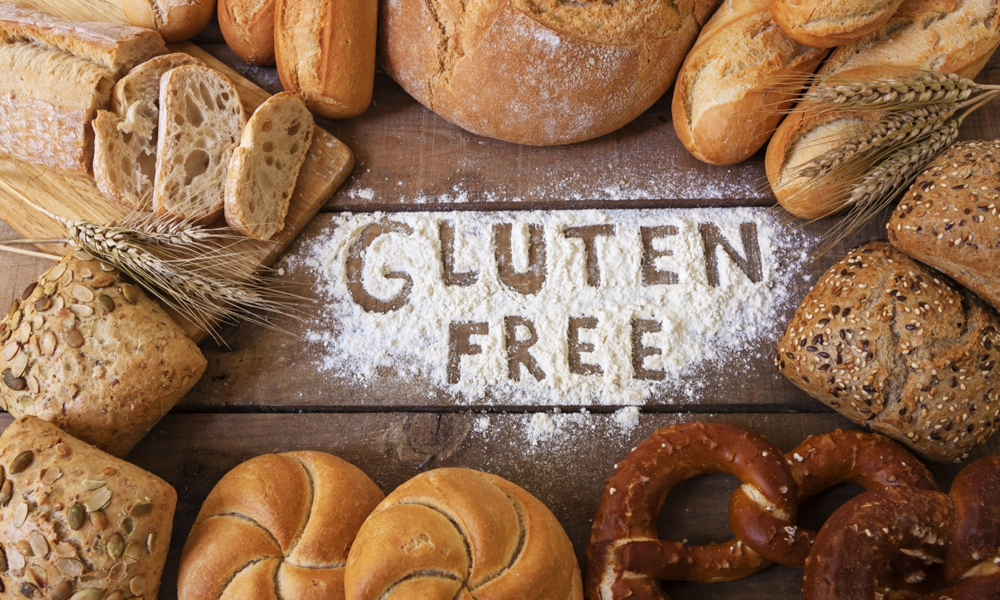
This is perhaps the best reason for a dog to eat gluten-free dog food products – to ensure that none of the other allergy triggers are in the dog food. Some dogs see improvement in allergy-like symptoms when going gluten-free, but it’s impossible to tell whether this is from the removal of the gluten itself or if it’s the result of another ingredient, like certain meat, dairy, and soy being removed from the pet food, too.
How to tell if your dog has a gluten intolerance
To determine if your pet has a gluten allergy or intolerance to another ingredient, including meat or grains like corn or soy, talk to your vet. There are two tests for diagnosing a wheat gluten allergy. One is an intestinal biopsy, where the vet uses a device to take a small sample of cells from your dog’s intestine and analyzes it under a microscope. Obviously, this is pretty invasive, but if your dog has severe symptoms after eating foods with grains, it might be necessary. The other test the vet can do is a blood test, using a small needle and a tube device to collect blood. This test is not as effective, but it’s a little easier on your dog and can identify if your pet is having an allergic reaction to ingredients like meat, grains, wheat in its food.
Sometimes, the vet may recommend switching foods from one that contains wheat to one that is gluten-free. They may also ask you to switch to something that uses a different type of meat, like bison or lamb instead of beef or chicken. After some time eating food with different ingredients, the vet will see if your dog’s symptoms improve. The following are symptoms of gluten intolerance:
- malnutrition
- weight loss
- weakness
- abdominal discomfort
- diarrhea
- vomiting
- dull coat
- failure to thrive
Best gluten-free dog food
If you’re looking for pet food that’s wheat gluten free and grain free, some of the most popular dog food brands have multiple options to choose from. Let’s take a look at a few of the best options from some well-known dog food brands.
Merrick Grain Free with Real Meat + Sweet Potato Dry Dog Food
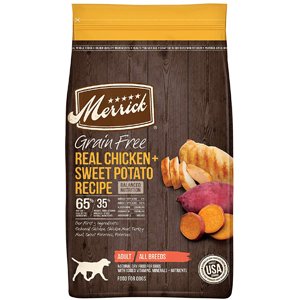
One of the best things about Merrick’s grain free dog foods is that it offers so many food recipes, including real meat like beef and bison, chicken, duck, lamb, salmon, Texas beef, turkey, and venison. We’re going to be looking at the beef and bison meat recipe, but each of these products is made according to the same high standards.
One of the main things to know about this grain free dog food is that it gets 72 percent of its protein from animal protein. Some dog food recipes use ingredients with plant proteins to beef up the overall protein content, but this is one of the dog food brands that does it right, using multiple types of meat like deboned bison, chicken meal, turkey meal, and deboned beef in the first five ingredients.
This food recipe contains 34 percent crude protein, 17 percent crude fat, and 3.5 percent crude fiber, and 379 kcal/cup.
Ingredient List: Deboned Bison, Chicken Meal, Turkey Meal, Potatoes, Deboned Beef, Sweet Potatoes, Peas, Chicken Fat, Whitefish Meal, Tapioca, Natural Flavor, Salmon Meal, Potato Protein, Pea Fiber Protein, Flaxseed, Sunflower Oil, Potassium Chloride, Salt, Apples, Blueberries, Organic Dehydrated Alfalfa Meal, Choline Chloride, Minerals (Iron Amino Acid Complex, Zinc Amino Acid Complex, Zinc Sulfate, Sodium Selenite, Manganese Amino Acid Complex, Copper Amino Acid Complex, Copper Sulfate, Potassium Iodide, Cobalt Proteinate, Cobalt Carbonate), Taurine, Yucca Schidigera Extract, Mixed Tocopherols for Freshness, Vitamins (Vitamin E Supplement, Vitamin B12 Supplement, Riboflavin Supplement, Vitamin A Acetate, d-Calcium Pantothenate, Thiamine Mononitrate, Folic Acid, Niacin, Biotin, Pyridoxine Hydrochloride, Vitamin D3 Supplement), Citric Acid for Freshness, Dried Lactobacillus Plantarum Fermentation Product, Dried Lactobacillus casei Fermentation Product, Dried Enterococcus faecium Fermentation Product, Dried Lactobacillus acidophilus Fermentation Product.
Taste of the Wild Dry Dog Food With Roasted Bison And Roasted Venison

Dogs love Taste of the Wild. This brand has a variety of grain free and gluten free dog food products, and this Roasted Bison and Roasted Venison recipe is one of the brand’s most popular foods. This is a high-protein recipe and contains multiple types of meat. Water buffalo, lamb meal, and chicken meal are the first three ingredients, followed by real vegetables, like sweet potatoes, peas, and potatoes.
Each serving delivers the nutrients that your dog needs to stay happy and healthy, including vitamins and minerals from superfoods, omega fatty acids for skin and coat health, and antioxidants for the immune system, and prebiotics for GI support.
This recipe is not only gluten-free, it’s also grain-free, with no corn or what and nor artificial colors or flavors.
This dog food is grain free and contains 32 percent crude protein, 18 percent crude fat, and 4 percent crude fiber, and 370 kcal/cup.
Ingredient List: Water buffalo, lamb meal, chicken meal, sweet potatoes, peas, potatoes, chicken fats (preserved with mixed tocopherols), egg product, roasted bison, roasted venison, beef, natural flavor, tomato pomace, potato protein, pea protein, ocean fish meal, salt, choline chloride, taurine, dried chicory root, tomatoes, blueberries, raspberries, yucca schidigera extract, dried Lactobacillus Plantarum fermentation product, dried Bacillus subtilis fermentation product, dried Lactobacillus acidophilus fermentation product, dried Enterococcus faecium fermentation product, dried Bifidobacterium animalis fermentation product, vitamin E supplement, iron proteinate, zinc proteinate, copper proteinate, ferrous sulfate, zinc sulfate, copper sulfate, potassium iodide, thiamine mononitrate, manganese proteinate, manganous oxide, ascorbic acid, vitamin A supplement, biotin, niacin, calcium pantothenate, manganese sulfate, sodium selenite, pyridoxine hydrochloride, vitamin B12 supplement, riboflavin, vitamin D supplement, folic acid. Contains a source of live (viable), naturally occurring microorganisms
Blue Buffalo Freedom Grain Free Natural Adult Dry Dog Food

Another popular grain free gluten free dog food is Blue Buffalo Freedom. We’re looking at the chicken recipe, but it’s also available in beef and lamb meat flavored foods.
The chicken recipe uses deboned chicken and chicken meal as the first two ingredients. It contains a precise blend of vitamins, minerals, and antioxidants in the form of LifeSource Bits that support immune system health. This recipe also has omega 3 and 6 fatty acids for skin and coat health as well and has an impressive ingredient list that contains no by-product meals or ingredients like wheat, corn, soy, or artificial flavors and preservatives.
This grain free pet food recipe contains 24 percent crude protein, 14 percent crude fat, and 6 percent crude fiber, and 373 kcal/cup.
Ingredient list: Deboned Chicken, Chicken Meal, Potatoes, Peas, Tapioca Starch, Pea Starch, Chicken Fat (Preserved With Mixed Tocopherols), Dried Tomato Pomace, Pea Protein, Flaxseed (Source Of Omega 3 And 6 Fatty Acids), Turkey Meal, Natural Flavor, Dicalcium Phosphate, Salt, Dehydrated Alfalfa Meal, Potassium Chloride, Choline Chloride, Dried Chicory Root, DL-Methionine, Pea Fiber, Alfalfa Nutrient Concentrate, Calcium Carbonate, Preserved With Mixed Tocopherols, Sweet Potatoes, Carrots, Garlic, Zinc Amino Acid Chelate, Zinc Sulfate, Vegetable Juice For Color, Ferrous Sulfate, Vitamin E Supplement, Iron Amino Acid Chelate, Glucosamine Hydrochloride, Blueberries, Cranberries, Barley Grass, Parsley, Turmeric, Dried Kelp, Yucca Schidigera Extract, Niacin (Vitamin B3), Calcium Pantothenate (Vitamin B5), L-Ascorbyl-2-Polyphosphate (Source Of Vitamin C), L-Lysine, Copper Sulfate, Biotin (Vitamin B7), L-Carnitine, Vitamin A Supplement, Copper Amino Acid Chelate, Manganese Sulfate, Taurine, Manganese Amino Acid Chelate, Thiamine Mononitrate (Vitamin B1), Riboflavin (Vitamin B2), Vitamin D3 Supplement, Vitamin B12 Supplement, Pyridoxine Hydrochloride (Vitamin B6), Calcium Iodate, Dried Yeast, Dried Enterococcus Faecium Fermentation Product, Dried Lactobacillus Acidophilus Fermentation Product, Dried Aspergillus Niger Fermentation Extract, Dried Trichoderma Longibrachiatum Fermentation Extract, Dried Bacillus Subtilis Fermentation Extract, Folic Acid (Vitamin B9), Sodium Selenite, Oil Of Rosemary.
Wellness CORE High Protein Grain Free Natural Adult Dry Dog Food
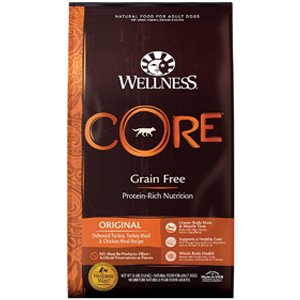
Wellness CORE is another great dog food recipe that’s grain free and gluten free. It’s loaded with healthy, high-quality ingredients like deboned turkey, turkey meal, chicken meal, and flaxseed and salmon oil, which are excellent sources of omega fatty acids. This recipe contains everything your dog needs for balanced nutrition, including probiotics for GI health, taurine for a healthy heart, and glucosamine for strong joints.
This grain free dog food recipe contains 34 percent crude protein, 16 percent crude fat, and 4 percent crude fiber, and 417 kcal/cup.
Ingredient List: Deboned Turkey, Turkey Meal (source of Glucosamine), Chicken Meal (source of Chondroitin Sulfate), Peas, Dried Ground Potatoes, Lentils, Chicken Fats (preserved with Mixed Tocopherols), Tomato Pomace, Ground Flaxseed, Natural Chicken Flavor, Salmon Oil, Taurine, Vitamin E Supplement, Choline Chloride, Chicory Root Extract, Spinach, Broccoli, Carrots, Parsley, Apples, Blueberries, Kale, Mixed Tocopherols added to preserve freshness, Zinc Proteinate, Zinc Sulfate, Calcium Carbonate, Niacin, Iron Proteinate, Ferrous Sulfate, Vitamin A Supplement, Copper Sulfate, Thiamine Mononitrate, Copper Proteinate, Manganese Proteinate, Manganese Sulfate, d-Calcium Pantothenate, Sodium Selenite, Pyridoxine Hydrochloride, Riboflavin, Biotin, Vitamin D3 Supplement, Yucca Schidigera Extract, Calcium Iodate, Vitamin B12 Supplement, Folic Acid, Ascorbic Acid (Vitamin C), Dried Lactobacillus Plantarum Fermentation Product, Dried Enterococcus faecium Fermentation Product, Dried Lactobacillus casei Fermentation Product, Dried Lactobacillus acidophilus Fermentation Product, Rosemary Extract, Green Tea Extract, Spearmint Extract.
Firstmate Pet Foods Pacific Ocean Fish Original
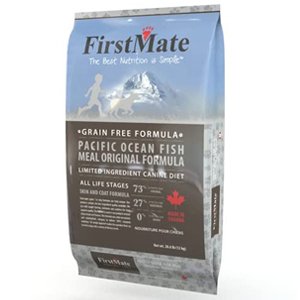
This ocean fish recipe from Firstmate Pet Foods is a good choice if you’re looking for products for your dogs that are not only grain and gluten free but also made using limited ingredients. It’s nutritionally balanced to support your dog’s health but uses novel proteins and unique ingredients that will satisfy your dog’s appetite.
This grain free recipe contains 23 percent crude protein, 10 percent crude fat, and 8 percent crude fiber and 484 kcal/cup.
Ingredient list: Potato, Wild Herring Meal and/or wild anchovy meal, and/or wild sardine meal, Tomato Pomace, Chicken Fats (preserved with mixed tocopherols), Fish Oil, dicalcium phosphate, choline chloride, calcium propionate, Yucca plant extract, Minerals (zinc proteinate, iron proteinate, manganese proteinate, copper proteinate, iodine, cobalt, selenium), Vitamins (vitamin E, riboflavin, niacin, d–pantothenic acid, thiamine, vitamin A, pyridoxine, folic acid, biotin, vitamin B12, vitamin D3), glucosamine
Are gluten free dog foods better?
There is a lot of discussion about whether or not grain free or gluten free food is better for dogs, but it really depends on the dog. Some dogs have severe allergies and sensitivities to food that improve drastically when eating a gluten free diet. In those cases, yes, gluten free dog food is better. Is gluten free dog food better for every dog? Not necessarily. Some dogs eat gluten without a problem. Whether you need grain free or gluten free dog food depends on your dog.
Gluten as an ingredient in itself is neither good nor bad. It’s a good source of protein for those who can tolerate it, but there’s nothing wrong with leaving it out of your dog’s diet if it benefits them.
The most common food allergies in dogs are chicken, beef, dairy, lamb, eggs, pork, soy, and fish. None of these contain gluten, but they are popular ingredients in the dog food industry. Notably, a meat ingredient is more likely to cause an allergic reaction than wheat gluten, unless the dog in question is suffering from Celiac disease.
But does this mean that all dogs can tolerate gluten? No!
If your dog doesn’t have Celiac disease but still experiences gassiness, poor appetite, weight loss, diarrhea, vomiting, and chronic skin problems, talk to your dog veterinarian about switching to a grain or gluten free dog food. If those problems go away when giving your dog pet foods without gluten, then it is entirely possible that gluten intolerance is what was causing its issues in the first place. You may not know which ingredient was ultimately causing the problem, but if the food eliminates your dog’s issues, does it really matter?
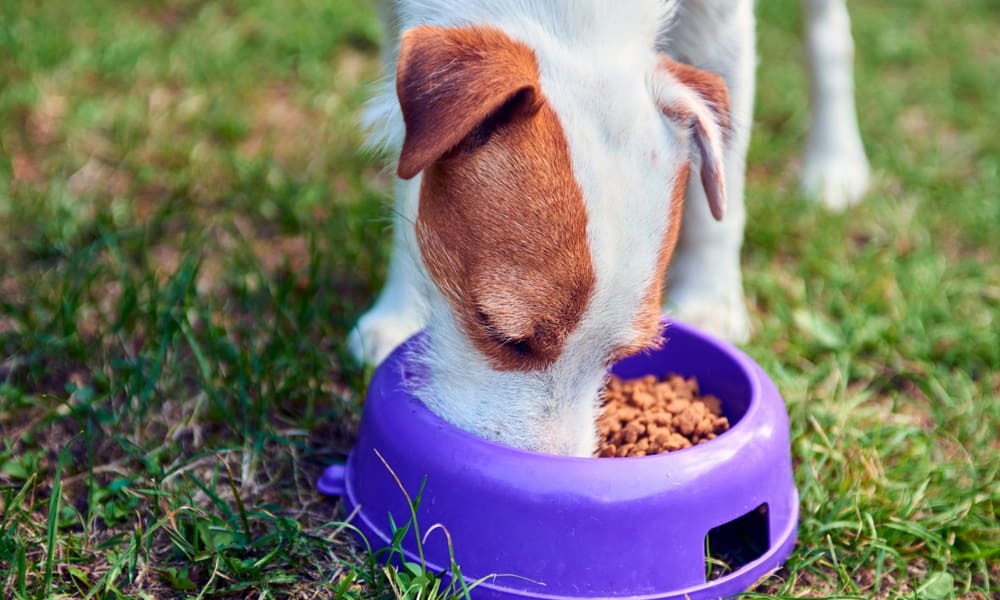
It’s important to note that the FDA has found some connection to grain-free diets and heart disease in some dogs. This is one reason why it is so important to talk to your vet before eliminating all grains from your dog’s diet. Gluten free and grain free are not the same. While all grain-free foods are gluten free, there are plenty of dog foods that contain grains without gluten, using things like corn and oats instead of wheat. Your vet will be able to tell you if your dog suffers from conditions that might make food without grains a little risky, they can tell you what dog food manufacturers to look at and the type of diet your dog needs to stay healthy.
How to make the switch to gluten free dog foods
One thing to keep in mind with switching to gluten free and grain free dog food is to be patient. First of all, you should take your time transitioning your dog from one food to another. And second, it may take some time to get your dog’s digestive system used to the new formula. You have to stick with the new wheat gluten free recipe for at least a few weeks to see the health benefits.
Make the switch from regular pet foods to gluten free dog food gradually. Plan for a week-long transition. Start with a mix of three parts old dog food to one part grain free or gluten free dog food. Stick with this mix of the two foods for two days. If your dog tolerates this okay, use a blend of half the old dog food and half the new gluten free food. Again, give this blend for a day or two. If your dog tolerates the food, move onto a blend of one part old dog food to three parts gluten free or grain free. Wait a few days, then transition to only using the new gluten free dog food for your dog’s diet.
Going slowly when switching has many benefits. First, it lets you accurately assess how well dogs adjust to new foods. If your dog seems to be tolerating it just fine, advance to the next stage. If not, slow down and give your dog some time to adjust to the new food and its ingredients. Wait an extra day or two to add in more gluten free food. Take as long as you need to to help your dog make a smooth transition to its new grain free, gluten free pet food. You should also follow this method when making any changes to your dog’s food, for example, when switching brands, grain free dog foods, or to any foods with different ingredients.
Make sure you talk to your dog veterinarian before making any major changes in your dog’s diet to make sure they recommend a gluten free pet food. Your vet may want to tests to rule out canine allergies or Celiac disease before making a recommendation about which food to try or what dog food brand has the best foods and ingredients for your pet.
I grew up in a household that was filled with animals. I believe that my fate as a dog-loving person was sealed in early childhood since my parents owned several dogs of varying sizes and breeds. There was no choice but to take care of and learn about dog habits and the best animal care practices — otherwise, I’d be clueless about how to go about the creatures I was surrounded by day and night.
As a life-long puppy lover, I know a thing or two about dogs and how to go about caring for them in the best way possible. Although I’m not a professionally trained dog behaviorist, trainer, or veterinarian, all of my knowledge and experience with canines comes from a place of love and a deep-rooted passion for dogs and animals in general.
Seeing as dogs kept me company throughout every stage of my life, I decided to follow a different path in my academic life and obtained a Bachelor’s and Master’s degrees in Marketing Management and Digital Advertising, which ultimately allowed me to combine my professional training and personal experience by creating the ultimate dog lover’s resource website! Along with my husband, Dave, I run MySweetPuppy for like-minded dog lovers who want to have a single, clear, and reliable information source about anything and everything related to dogs and their well-being.
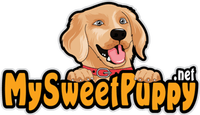
![The Best 4 Low Sodium Dog Foods [2021 Buyer’s Guide]](https://mysweetpuppy.net/wp-content/uploads/2015/12/low-sodium-dog-food1.jpg)
